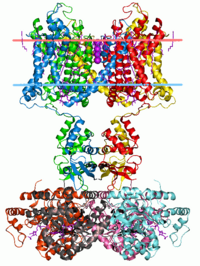
Photo from wikipedia
Ion permeation, selectivity, and the behaviour of the K+ channel selectivity filter has been studied intensively in the previous two decades. The agreement among multiple approaches used to study ion… Click to show full abstract
Ion permeation, selectivity, and the behaviour of the K+ channel selectivity filter has been studied intensively in the previous two decades. The agreement among multiple approaches used to study ion flux in K+-channels suggests a consensus mechanism of ion permeation across the selectivity that has been put to test in recent years with the proposal of an alternative way by which ions can cross the selectivity filter of K+-channels via direct Coulomb repulsion between contacting cations. Some past experimental work by Zhou and MacKinnon showed that mutation of site S4 reduces the total occupancy of the selectivity filter to less than two ions on average by lowering the occupancy of the S2-S4 configuration without changing the S1-S3 configuration much, and this reduction of occupancy means that ion configurations others from the ones involved in the canonical mechanism are likely to be involved. At that time, calculations using complicated kinetic networks to relate occupancy to conduction did not provide deeper insight into the conduction mechanism. Here, to help solve this enigma, umbrella sampling simulations have been performed to evaluate the potential of mean force of two KcsA mutant channels, where the S4 site is substituted. Our new results provide insights into the significance of threonine in this position, revealing the effect of substitution on the alternate mechanisms of conduction proposed, involving either water or vacant sites.
Journal Title: Journal of chemical theory and computation
Year Published: 2019
Link to full text (if available)
Share on Social Media: Sign Up to like & get
recommendations!